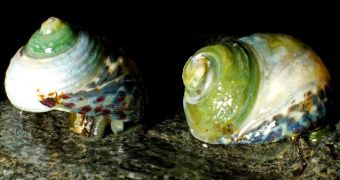Water surfaces, oceans and seas in particular, are natural sinkholes for carbon dioxide gas. And it just so happens that man made sure that Earth's atmosphere has plenty of carbon dioxide, which is absorbed into water, thus making it more acidic in the respective areas. This in turn affects the marine life such as snails and their shells that are being dissolved by acidified water. Jason Hall-Spencer of the University of Plymouth says that the harm has already been done and not even a sudden decrease in carbon dioxide concentrations could stop the further acidification of water.
"It's clear that marine food webs as we know them are going to alter, and biodiversity will decrease. Those impacts are inevitable because acidification is inevitable - we've started it, and we can't stop it", he said. Many of the marine species having calcium carbonate based external skeletons, including corals and mollusks, are affected because, as water becomes ever more acidic, calcium carbonate concentrations in the water decrease, leaving them with little resources to build their skeletons on.
Currently, the global pH of the sea water averages 8.1, which is about 0.1 lower than the value registered prior to the industrial revolution. Around carbon dioxide sinkholes, the pH of the water can be as low as 7.4 while a pH of 7.9 could produce enough damage in the marine life to result in a decrease in species of up to 30 percent. In critically affected areas coral is already absent and species of algae based on calcium carbonate have been replaced by those that do not require it. In areas where the pH drops to 7.4 no snail populations were found either, while in areas with lower acidity shell disintegration is clearly visible.
On the other hand, seagrass exploiting the excess of carbon dioxide seems to be thriving. "I can't count the number of times that scientific talks end with 'responses have not yet been documented in the field'. This paper puts that to rest for several ecologically important marine groups", said Elliott Norse, president of the Marine Conservation Biology Institute.
Meanwhile, the Intergovernmental Panel on Climate Change predicts that, unless the carbon dioxide gas emissions are drastically reduced, the overall average sea water pH could drop to 7.8 in the next century or so, meaning that the Mediterranean area (where data was collected) is a major carbon dioxide sinkhole and will fully suffer the consequences of water acidification. "I think we will see the same pattern in other parts of the world, because we're talking about keystone species such as mussels and limpets and barnacles being lost as pH drops", said Dr Hall-Spencer.
The western coast of the American continent is also expected to turn to a higher acidity in the near future, while the southern oceanic regions are less affected since they do no suffer from the impact of high carbon dioxide concentrations in the atmosphere. Highly acidic water can be naturally found in oceans, although it is restricted to greater depths. Corroborating this with the rise in carbon dioxide concentrations reveals a possible pH of 7.5. "If pH 7.8 is a universal 'tipping point', then it indicates that sections of the western coast waters off North America may have passed this threshold during periods when this upwelling of waters high in CO2 occurs", said Carol Turley from Plymouth Marine Laboratory.
And as if the rise in carbon dioxide levels were not enough, climate change is also playing its part in the destruction of marine life. Corals, for example, are only one of the many organisms affected by the rise in water temperature. "The reason that the oceans are becoming more acidic is because of the CO2 emissions that we are producing from burning fossil fuels. Add CO2 to seawater and you get carbonic acid; it's simple chemistry, and therefore certain. This means that the only way of reducing the future impact of ocean acidification is the urgent, substantial reduction in CO2 emissions", Dr Turley concluded.

 14 DAY TRIAL //
14 DAY TRIAL //